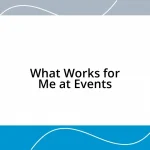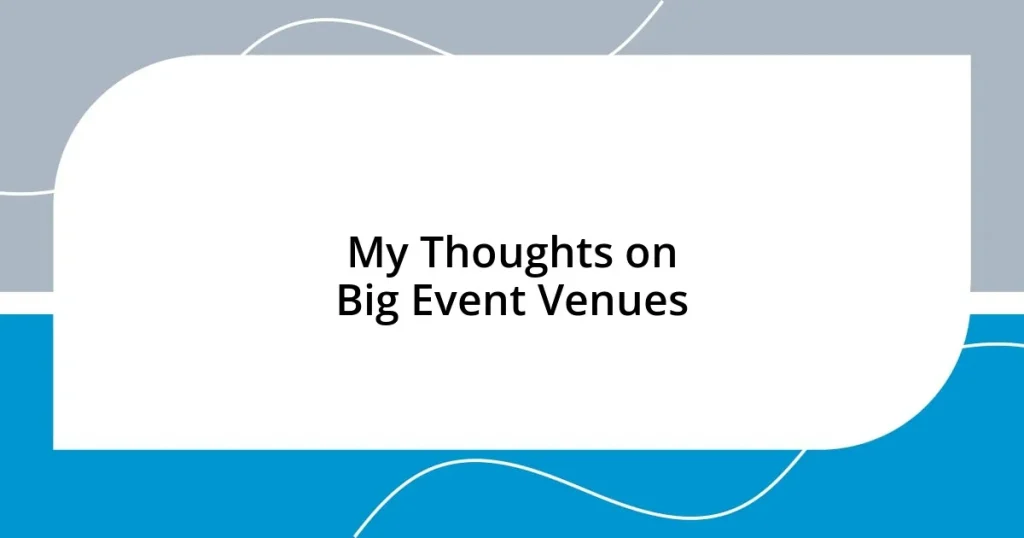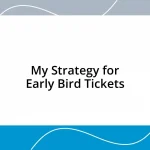Key takeaways:
- Big event venues must facilitate connections through thoughtful design and layout for a memorable experience.
- Key factors in venue selection include accessibility, ambiance, technical capabilities, and customer service.
- Understanding the type of venue—convention centers, outdoor venues, or sports stadiums—is crucial for fitting the event’s needs and atmosphere.
- Effective logistics planning and clear communication are essential for smooth event execution, including contingency plans for unexpected challenges.
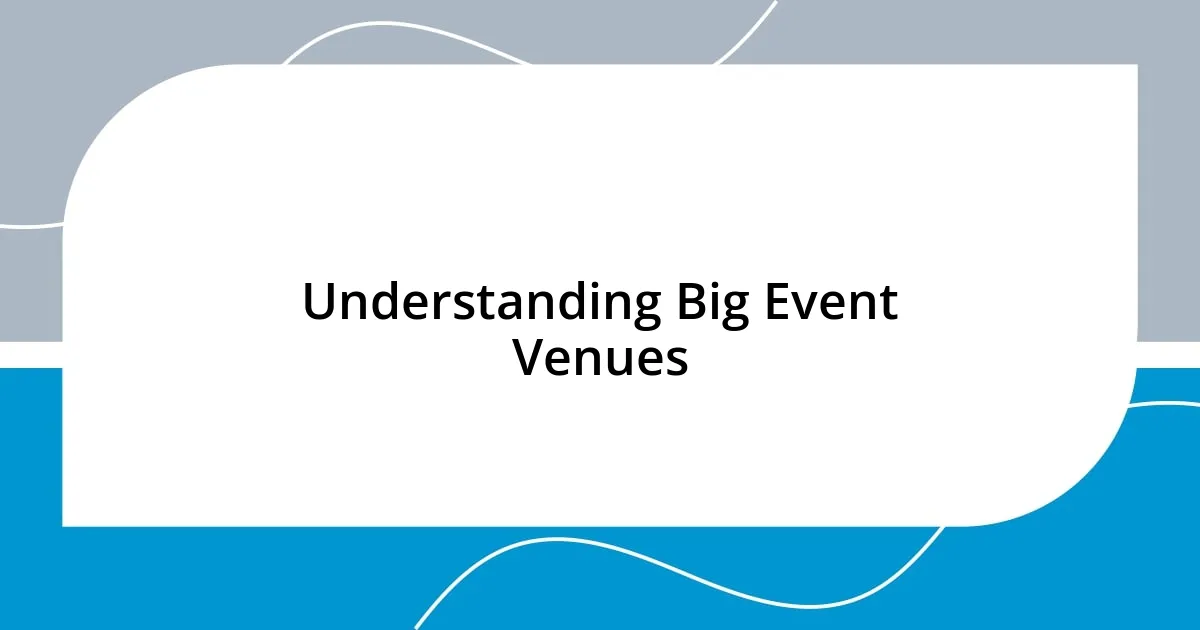
Understanding Big Event Venues
When I think about big event venues, I can’t help but recall my first experience at a sprawling convention center. The sheer scale of the space took my breath away; it felt like stepping into a small city. Isn’t it fascinating how the atmosphere changes as you move through these vast areas, each section buzzing with its own unique energy?
What strikes me most about these venues is their ability to adapt. I remember attending a music festival that transformed a football stadium into a vibrant playground for art and culture. It makes me wonder: what makes a venue truly versatile? Is it the layout, the acoustics, or the staff? Each element plays a vital role in shaping our experience, making it memorable or forgettable.
From my perspective, the success of a big event largely hinges on the venue’s ability to facilitate connections. I once attended a conference that flourished due to its well-curated breakout areas, fostering conversations that sparked meaningful collaborations. Have you ever left an event and felt like you gained something more than just information? That’s the magic of a thoughtfully designed venue.
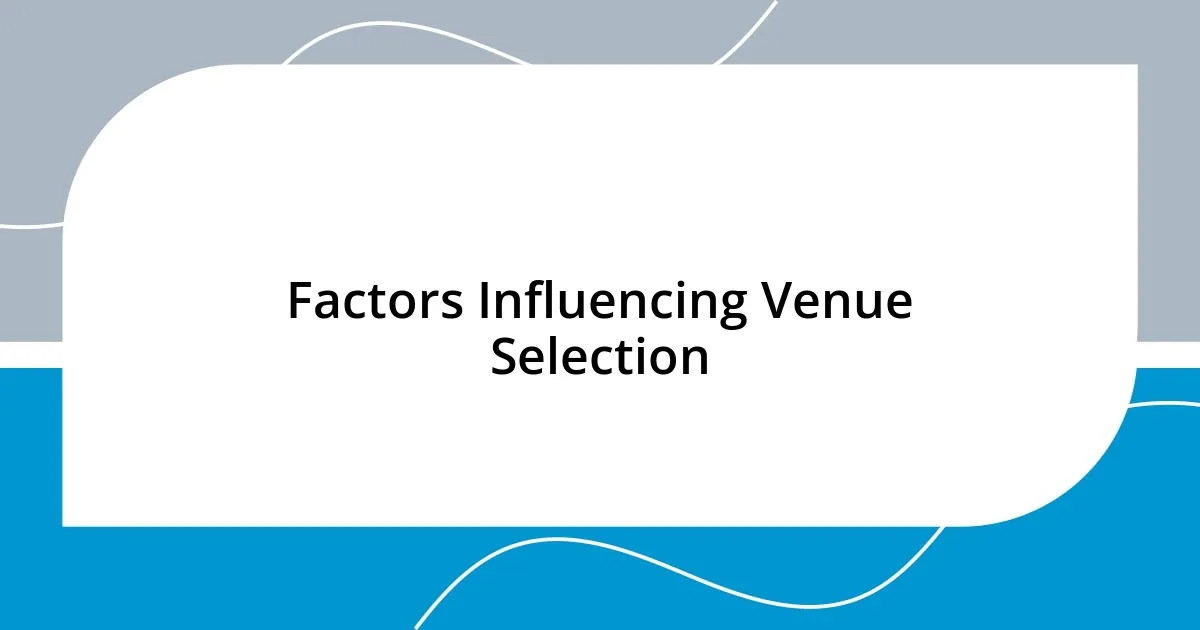
Factors Influencing Venue Selection
When selecting a venue for a big event, several factors come into play that can significantly impact the overall experience. For me, accessibility is paramount; I can recall attending a trade show at a venue that was difficult to reach. The frustration from my peers and I trying to navigate public transport diminished the excitement before we even entered. Additionally, the venue’s ambiance sets the tone for the event. A well-lit, aesthetically pleasing space can uplift spirits, whereas a dull atmosphere can drain energy.
Here are some key factors to consider when choosing an event venue:
- Location and accessibility
- Space capacity and layout
- Technical capabilities (AV equipment, Wi-Fi, etc.)
- Amenities offered (restrooms, parking, catering services)
- Ambiance and aesthetic appeal
I’ve also learned the hard way that high-quality customer service is crucial. I once organized a small business conference where the venue staff went above and beyond—accommodating last-minute requests while maintaining a positive attitude. Their support made a world of difference in how seamless the event unfolded. Each of these factors weaves into the fabric of the overall event experience, demonstrating just how critical venue selection is.
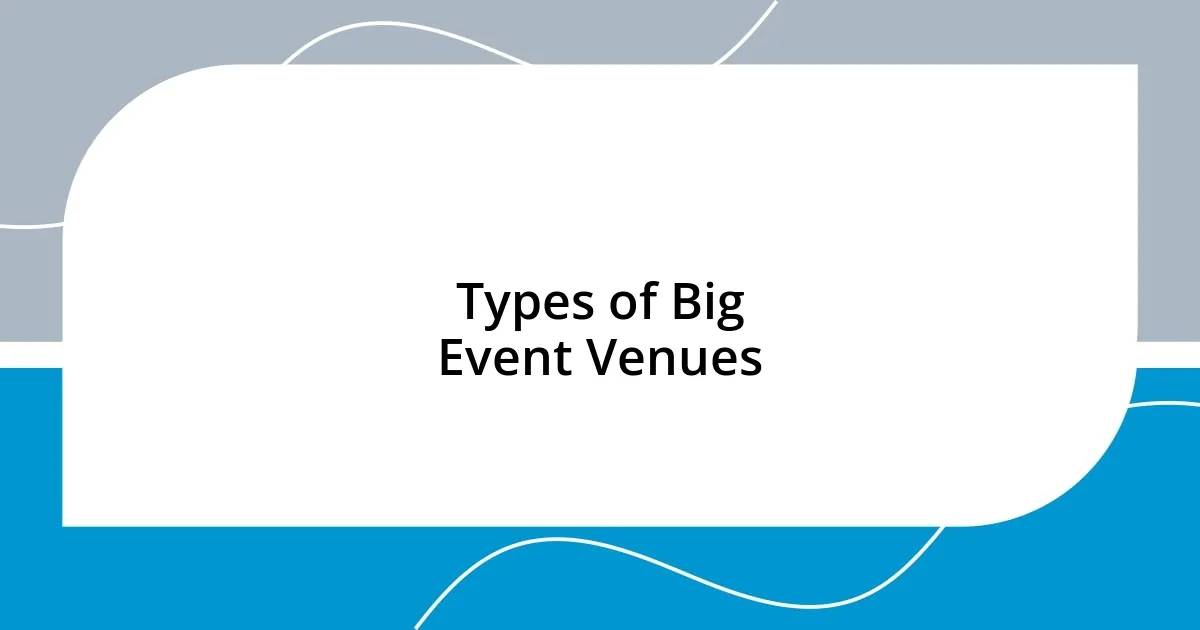
Types of Big Event Venues
Choosing the right type of big event venue is crucial, as each category brings its own flair and functionality to the table. From my experience, convention centers are like blank canvases. I attended an industry expo there, and it amazed me how the space could be transformed to fit different themes—from tech showcases to art exhibitions. The versatility of these venues never ceases to inspire me.
On the other hand, outdoor venues carry a charm that indoor spaces often struggle to replicate. I remember a beautiful wedding held at a vintage estate, where the natural beauty surrounding the ceremony created an unforgettable atmosphere. The open air allowed the laughter and music to ripple through the gardens, making each moment feel intimate yet grand. It reminds me that the environment can enhance the experience profoundly.
Sports stadiums often feel like colossal playgrounds for events, and they generate an energy that’s hard to match. I once saw a concert at a stadium that was packed to the brim; the energy from the crowd reverberated, making it an exhilarating experience. These venues can accommodate thousands, reminding us that sometimes, bigger really is better when it comes to certain events.
| Type of Venue | Highlights |
|---|---|
| Convention Centers | Versatile spaces, adaptable for various events |
| Outdoor Venues | Natural beauty enhances atmosphere, great for intimate gatherings |
| Sports Stadiums | Massive capacity and energetic vibe, perfect for large concerts or festivals |

Key Features of Ideal Venues
When considering the key features of ideal venues, the layout and space capacity are fundamental. I remember attending a corporate gala where the seating arrangement was awful. Guests were squeezed together, making it hard to mingle. A well-planned layout can make or break the interactions between attendees. Can you imagine being at an event where people effortlessly flow from one area to another rather than feeling trapped in a corner?
Technical capabilities are another critical aspect I’ve learned to prioritize. I once participated in a live-streamed event where the audiovisual setup faltered. The awkward silence while technicians scrambled to resolve issues was painful. A venue equipped with reliable Wi-Fi and state-of-the-art AV equipment ensures that the event runs smoothly and keeps the audience engaged. It’s incredible how seamless technology can elevate an event’s impact.
Finally, the amenities offered can greatly enhance the attendee experience. At a recent conference I attended, the venue included charging stations and comfort lounges. It made it easy to recharge—not just devices, but our energy too. Simple things like well-maintained restrooms and ample parking can leave a lasting impression. Who hasn’t felt relieved walking into a venue where everything is just… right? These details may seem minor, but they significantly contribute to the overall satisfaction of your event.
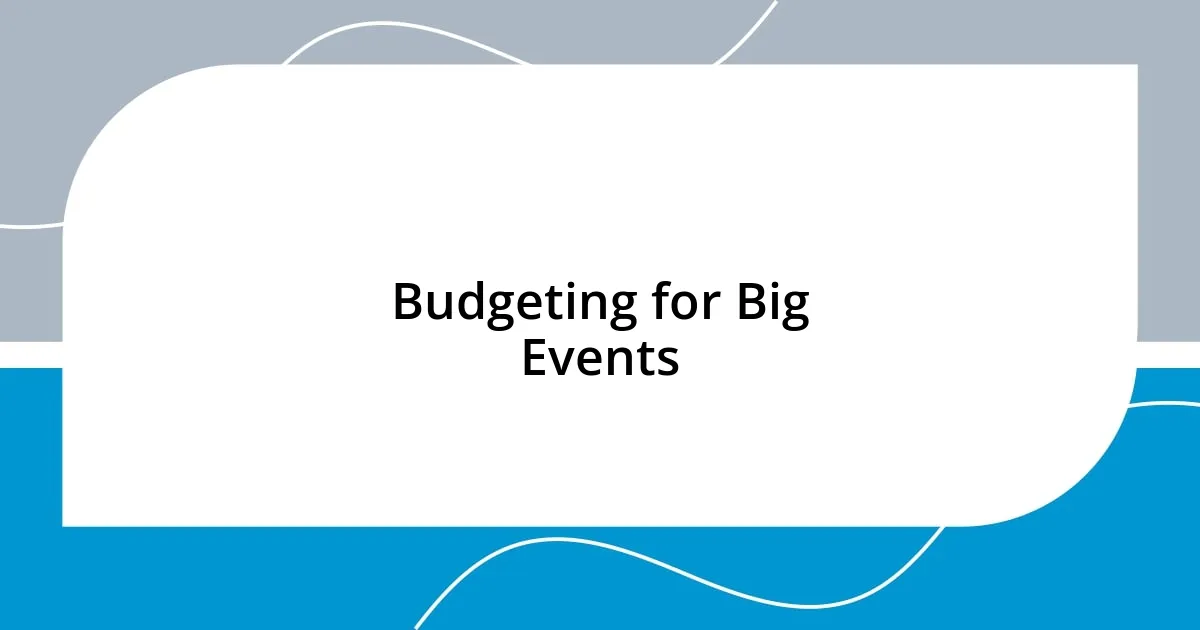
Budgeting for Big Events
Budgeting for big events can feel overwhelming, but I’ve found that a clear financial plan can alleviate a lot of stress. When I organized a charity gala, I set a detailed spreadsheet with every potential expense I could think of—from catering to decor. It was a bit tedious at first, but it helped me identify where I could save and where to splurge for maximum impact.
I remember wanting that perfect venue, but its rental fee was sky-high. It got me thinking about creative options. Could a local park or community center provide an equally charming backdrop at a fraction of the cost? The answer was yes! Exploring unconventional spaces often led to unique experiences and allowed me to stretch my budget further.
Don’t forget the unexpected costs that can pop up, like last-minute changes or extra equipment rental. I once faced a sudden need for additional seating just days before an event. Having a contingency fund allows you to address these surprises without a panic. It taught me that flexibility is key in budgeting, and by planning ahead, I could still enjoy the event without stress. How do you approach budgeting for your events?
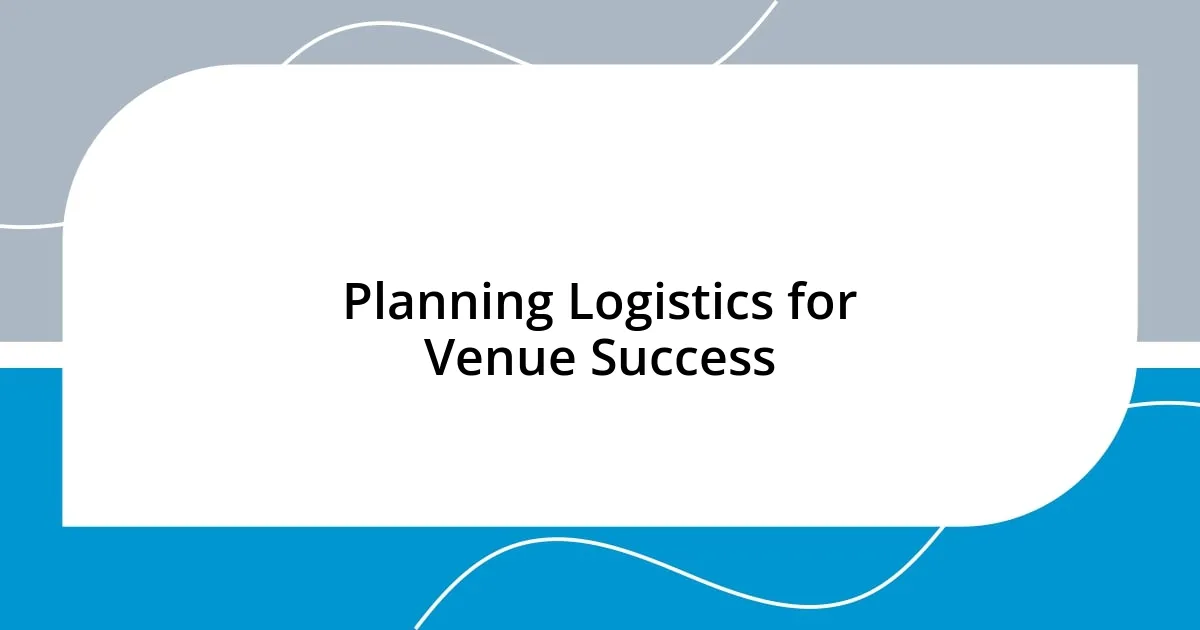
Planning Logistics for Venue Success
Planning the logistics for a venue can sometimes feel like piecing together a puzzle. I remember one event where the schedule seemed perfect on paper, yet we encountered chaos when the caterer showed up late. It made me realize that coordinating timelines—down to the minute—is crucial to ensure everything runs smoothly. Have you ever experienced that heart-sinking moment when things just aren’t syncing? It’s essential to have a plan that includes buffer time between activities, helping to alleviate any unforeseen delays.
Another vital aspect lies in communication. When I was involved in planning a large conference, we utilized a group chat for real-time updates. This turned out to be a game-changer! Everyone on the team was notified instantly if something changed—a speaker running late, or the need to shift a presentation. I can’t emphasize enough how important it is to keep everyone in the loop. It not only eases stress but fosters a sense of teamwork that can uplift the entire experience.
Lastly, considering the flow of guests throughout the venue is imperative. At an event I attended, poor signage led to people wandering around aimlessly, which diminished their enjoyment. I couldn’t help but think how crucial clear signage and helpful staff members are in guiding attendees smoothly from one area to another. It’s about creating an environment where guests can focus on enjoying the event instead of struggling to find their way. What strategies do you think are most effective in enhancing guest flow?
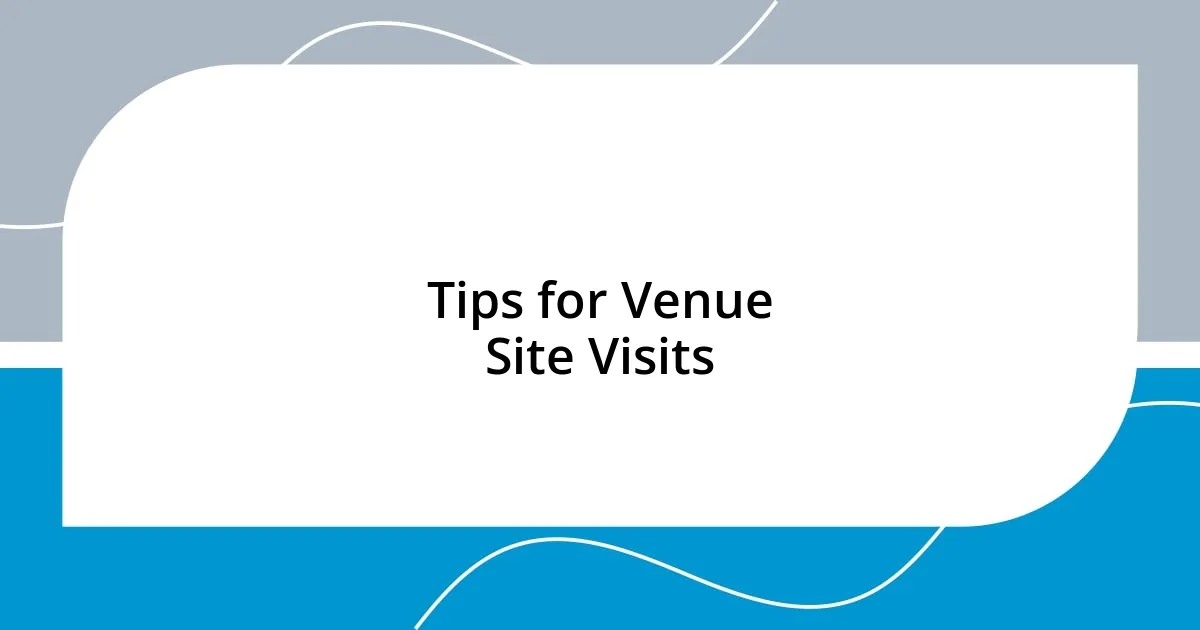
Tips for Venue Site Visits
To get the most out of a venue site visit, I recommend bringing along a checklist of essential criteria you’re looking for. During my last venue tour, I jotted down everything from capacity and layout to amenities like audio-visual equipment and parking options. This simple act kept me focused, ensuring I didn’t overlook any details that could impact the event experience.
It’s also incredibly helpful to envision your event while you walk through the space. I vividly recall standing in an open ballroom and picturing where my guests would mingle, dine, and dance. The emotional resonance of that visualization made it easier to assess whether the venue could meet my expectations. Does the space inspire creativity or connection? Asking myself these questions allowed me to gauge how the atmosphere could enhance the overall event.
Engage the venue coordinator during your visit; they often hold a treasure trove of insights. I once learned about unique lighting options and modular seating configurations from a venue manager that I hadn’t considered. Their expertise can help shape your vision and might lead to exciting ideas that can elevate your event. What personal touches can you add with their guidance to make the venue truly your own?





